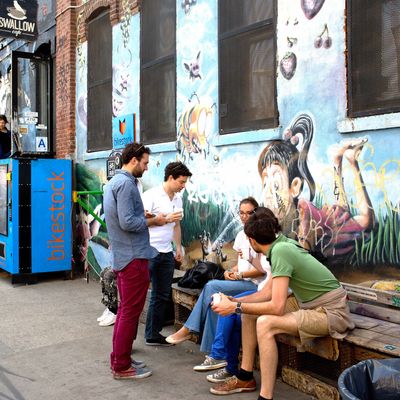
Gentrification is an incredibly hot subject right now — it seems to be the subject of endless articles and hot takes, as people try to decide just how damaging it is that people with money are suddenly taking an interest in so many once-undesirable neighborhoods in New York, D.C., and other cities, often leading to rising rents and longtime residents being forced to live elsewhere.
But what if gentrification just isn’t as big a piece of the inequality puzzle as everyone thinks? That’s the thesis of an interesting post and accompanying infographics at City Observatory, an organization that studies urban issues (and is funded by the Knight Foundation). The post, as the headline of one of the infographics puts it, argues that “Concentrated poverty is a bigger problem than gentrification.”
“Bigger problem” can mean a lot of things here, of course. Here’s how Joe Cortright, an economist at City Observatory and the author of the post, explains:
Neighborhood change has been a hot topic in many American cities—and, increasingly, on the national stage—for a number of years. At City Observatory, we’re especially interested in shifting community demographics as they relate to economic and racial integration, which have been shown to have profound impacts on people’s class mobility, longevity, and more.
But while most of the focus has been on gentrification—the process of middle- and upper-income people moving into lower-income neighborhoods—our own research shows that low-income communities are much more likely to suffer from the opposite problem: increasing poverty and severe population decline. Three-quarters of neighborhoods with a poverty rate twice the national average in 1970 still had very high levels of poverty in 2010, and had lost an average of 40 percent of their population. That represents a much larger number of people who have been “displaced” by a lack of opportunity or high-quality public services than have been displaced by gentrification.
Reading this immediately brought me back to the sociologist Matthew Desmond’s phenomenal book Evicted, which I interviewed him about in March. In that book, he embedded himself with a bunch of low-income Milwaukeeans facing agonizing housing difficulties — many of them, in part because they were perpetually short on cash, ended up getting evicted over and over. For the most part, these weren’t people who could afford to live anywhere near “gentrifying” neighborhoods. Rather, they were at the very bottom of the housing market, and, as Desmond explains, because there’s such unmet demand for housing, they were perpetually searching — desperately — for utterly ramshackle units they could barely afford anyway. Even the cheapest units aren’t “cheap” for the people and families who need them.
This doesn’t account for everything Cortwright is writing about, of course, but it’s part of the story of urban poverty (and addiction and crime and all of poverty’s other correlates), a big one, and it’s one of many examples that don’t really have a huge amount to do with gentrification. The problem is that there simply isn’t enough cheap housing even in poor neighborhoods gentrifiers want nothing to do with, anyway.
And yet the popular conversation about cities does seem to be focused way more on gentrification than on the sorts of stuff Desmond writes about. Cortwright thinks that’s partially because “Our perceptions of neighborhood change are often shaped by those places that are experiencing the greatest pace of change.”
That’s true, but I’d take that a step further: This also has to do with the question of which sorts of neighborhoods journalists themselves are going to be most familiar with. A huge number of journalists live in gentrifying neighborhoods, or visit them for restaurants and nightlife, and hardly any live in truly poor neighborhoods. If you compared the number of journalists living in Crown Heights, a rapidly gentrifying part of Brooklyn, to the number living in Brownsville, a poor and violent part of the borough just down the road, the difference would be stark. More broadly, journalists have a well-known bias toward focusing on issues of interest to people with money, and it’s people with money who move into gentrifying neighborhoods.
In short, journalists are, of course, just as susceptible to bias as anyone else, so when they try to figure out what stories matter the most, and what’s worth writing about, it’s no wonder that gentrification comes in high on that list. And then, from the point of view of people with a casual interest in cities or inequality or whatever else, when they search for information on theses subjects (or have it served up to them via social media), the most prominent subject discussed, for the above reasons, is … gentrification.
None of this means gentrification doesn’t bring real challenges with it for a lot of people, of course, and this conversation is just the tip of a really complicated iceberg when it comes to that subject. But it’s an interesting example of how people’s concerns get focused on certain topics at the expense of less sexy — but maybe more important — others.

